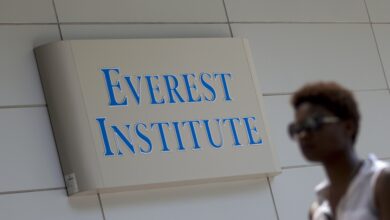Why One Researcher Says Legacy Preferences in Admissions Must End Soon

[ad_1]
James S. Murphy puts it this way in a new report: “It is time for colleges and universities to catch up to the 1770s and say goodbye to what essentially amounts to an aristocratic system, in which a few children inherit a birthright advantage in a process that wraps itself up in the cloth of meritocracy.”
It’s baked into the mythology of America: We don’t believe in aristocracy. And we think education is, in fact, the antidote to aristocracy.
Murphy, a senior policy analyst at Education Reform Now, brings his researcher’s chops and writer’s voice to a longstanding debate: Is it right for colleges to give children of alumni a leg up in the admissions process? The question gained new urgency after the Supreme Court agreed this year to hear legal challenges to race-conscious admissions policies at Harvard University and the University of North Carolina at Chapel Hill.
If the highest court bars the use of race in admissions, as many experts predict it will, then selective colleges will have to reassess all of their admissions practices. And, Murphy argues, they will have an even greater moral obligation to scrap legacy preferences, which overwhelmingly benefit white, affluent students. Unless, of course, they want existing enrollment gaps between white and nonwhite students to grow even wider.
Opposition to legacy preferences dates all the way back to the 1960s, as Murphy explains. Since then, Democratic and Republican politicians have taken aim at them (if any T-shirt could unite the right and left, it just might say “Ban Legacy Admissions Now!”). Murphy traces that history and offers an illuminating snapshot of the present, including a tally of colleges using legacy preferences (nearly 800 in 2020, or about half of all institutions that completed the Common Data Set).
That’s a big number, but it’s getting smaller. In 2020, the Johns Hopkins University announced that it had stopped considering legacy status. The following year, Amherst College announced the same. Those institutions might seem like outliers, but Murphy’s research confirms that they’re not: Recent data, he found, show that dozens of colleges have abandoned the practice, only with little or no fanfare.
Colleges aren’t so transparent about their use of legacy preferences. It took an epic lawsuit to pry loose the revelation that, as the report notes, the children of alumni at Harvard with the highest academic ratings are more than twice as likely to get an acceptance than low-income applicants with similar ratings. Among Murphy’s recommendations: The U.S. Department of Education should require disaggregated data reporting on the use of legacy preferences at each college, allowing the public to see how the practice affects various subgroups of students: “If the Supreme Court strikes down the use of race-conscious admissions policies in its current term, as is expected, disaggregated data will be essential for tracking the effects of that ruling in the years to come.”
Recently, Murphy talked with The Chronicle about his research, the grip of aristocratic traditions on college admissions, and the intricacies of what he calls “a shameful practice.”
This interview has been edited for length and clarity.

Courtesy of James S. Murphy
Many experts predict that the Supreme Court will soon bar the use of race in admissions. If that happens, you write, it will be “absolutely necessary” for colleges to end legacy preferences. Why?
One thing the Harvard case did was expose the influence of a range of admissions practices in college admissions, including legacy preferences. The other thing it did was make very clear just how important diversity is to highly selective colleges. That’s not to say other colleges don’t care about diversity. It’s just that it’s a more pointed issue at highly selective colleges, because the standards they set are very tilted in favor of wealth. And in American society, wealth is tilted toward white students. So it’s important to say that places like Harvard really have a strong commitment to racial and ethnic diversity. I don’t doubt that in any way whatsoever.
One of the planks of the Students for Fair Admissions case was that Harvard hasn’t taken enough race-neutral steps to protect diversity or to enhance diversity on campus. While I think the SFFA argument about race is wrong, I do think they’re right that Harvard could go further. So if campuses are going to maintain the level of diversity they have, let alone enhance it, they’re absolutely going to have to chip away anything that gets in the way of diversity. And there’s just no debate about this: The numbers are there in the Harvard case, and they show clearly that legacy preferences favor white students.
So a major shift in context — a land without race-conscious admissions — could have ripple effects.
Six months ago, I don’t know that I thought that the likely outcome of the Harvard and UNC cases was going to have much impact on the use of legacy preferences. But as I thought about it, two things became apparent. One is that, from a practical perspective, colleges are going to have to look at anything they can to free up spots that are currently reserved for largely white, wealthy students.
But then there’s the other ethical question, or the question of public perception. Come next June, if the Supreme Court says that colleges can no longer take into consideration a student’s race, which is an important part of a person’s whole being, it is almost impossible to imagine that colleges will then stand up and say, “Oh, but we’re fine with giving a preference to the children of our alumni.” It just becomes impossible, I think, to to say that without blushing, right?
As you make clear in your brief, legacy preferences are unpopular, among the general public and among admissions leaders, who give them a major thumbs down.
One of the findings of this study, not a big surprise at all, was that people hate legacy preferences. Seventy-five percent of Americans said legacy status should not be a factor in admissions, according to a Pew survey, which was reinforced by a recent Washington Post survey. The more surprising finding was the Inside Higher Education survey, where a large majority of admissions directors did not support the use of legacy preferences. So everybody hates them, even people working in colleges, except for alumni.
I think the Supreme Court decision is going to give college presidents and boards the cover they need to do something that they know is the correct thing to do, and that they have probably wanted to do for a while. I don’t think that the presidents of Stanford, Yale, and Princeton looked at Johns Hopkins’s decision to drop legacy preferences and said, “Oh, what a terrible idea.” I suspect they were deeply jealous of their bravery.
One eye-opening finding of yours is that 102 colleges have stopped considering legacy status since 2015, which, in most cases, seems to have happened rather quietly. Did that number surprise you? And what do you make of this trend?
It did surprise me. The reason I wanted to look at that is because there’s a myth that legacy preferences are an intractable problem, that they’re so beneficial for universities that they’re going to fight to the death to hold on to them.
The reality is I found that 80 percent of the 64 uberselective colleges — colleges that admit 25 percent or less of their applicants — do indeed offer legacy preferences. So when when Amherst did it, we were like, “OK, cool. But what about all these other liberal-arts colleges?” When Johns Hopkins did it, we were like “Cool. But what about all these other places?”
Most places that drop legacy preferences don’t do it noisily. Going through the data, I identified 102 colleges, and a ton of them were state institutions. In many cases, the flagships had dropped the practice quietly, and did it with some thoughtfulness and consideration, because they had to tell somebody to go in and change the box from considered to not considered. That was really surprising to me, and it pushes back against this notion that this is an intractable practice, that we’re never going to get rid of it.
Well, over 100 institutions have done so, they just haven’t all done so quite so loudly. I would like them to be louder and clearer about it. But that number also gave me hope that it would inspire similar confidence, especially in our public institutions. It’s shocking that any public college or university would provide a legacy preference. That’s a betrayal of their particular mandate to serve students in their state, where taxpayers are supporting them.
Some college leaders have described legacy preferences as a means of building and sustaining a special kind of community over time, one that helps nourish the institution, maintain bonds, and so on. Duke’s president recently described this in terms of “family.” What’s your response to this rationale?
It’s, at best, laughable. But honestly, I think it’s kind of grotesque because, as I write in the report, you’re talking about an institution that has a lot of wealth, that has a lot of power, that has a continuing influence on the broader society. When you confuse institutions like that with family, you’re not talking about college anymore, you’re talking about aristocracy.
It’s baked into the mythology of America: We don’t believe in aristocracy. And we think education is, in fact, the antidote to aristocracy. This notion that by using legacy preferences, colleges are preserving a community or a family runs right in the face of that.
I want to circle back to something you mention in the report: The tendency of some admitted legacy students who wonder if they deserved to get in. Does this reveal or suggest a truth about legacy preferences on a human level?
There are many reasons to get rid of legacy preferences, and the basic question of justice and fairness is the main one. But I also think legacy preferences can be bad for the beneficiaries, and there’s been reporting on this. If you have been admitted knowing that your father and mother grandparents went there, and knowing that this helps you get in, there’s going to be lingering doubts. Do I belong here? Did I only get in because my parents went here?
All college admissions officers, presidents boards and trustees want students to feel like they belong on campus, right? They want them to feel part of it. Let’s go back to that word “community.” The irony is that legacy preferences can undermine that very principle of community, of family, of belonging, that defenders of the practice are trying to invoke as a reason to use legacy preference. It can have the opposite effect.
So it seems like the bottom-line question here is this: Knowing what we know in 2022, can an institution truly claim that it stands for racial equity and socioeconomic diversity if it gives preferences to legacies?
I hope that is the question they ask themselves. And I hope the answer they arrive at is No. Because the correct answer is that you cannot possibly stand up for this preference if you also think your mission is to create a diverse campus that will benefit every single student on that campus and prepare them for the workplace.
[ad_2]
Source link






